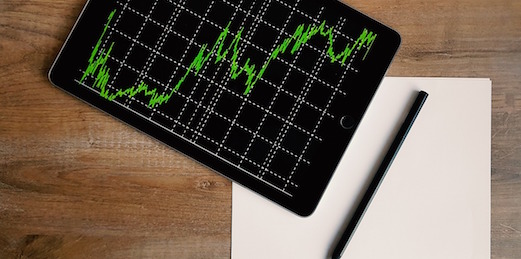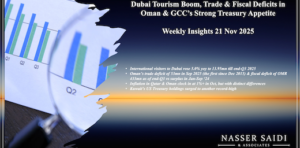Markets
News that China and US have agreed on the text of a phase one trade deal, which will see the removal of tariffs on Chinese goods in stages alongside US scaling back some tariffs, supported markets: US’s 3 equity indices and the MSCI world index hit record highs, while in Europe also markets ended in the green on hopes of an “orderly Brexit”. Saudi Tadawul saw the listing of Aramco, which drove up the market on Wed-Thurs; markets were mixed elsewhere in the region with Abu Dhabi, Egypt, Qatar and Oman losing vis-à-vis the week before. The pound rose to a 19-month high on the Tory election win; the dollar fell to an 18-week low against the CNY before recovering later. Oil prices were at the highest level in almost 3 months and gold prices were little changed.
Global Developments
US/Americas:
- The Fed kept policy rates unchanged, as expected, and also indicated that the rates would hold at least through next year.
- US price inflation was 0.3% mom and 2.1% yoy in Nov (Oct: 0.4% mom and 1.8% yoy), given higher gasoline and food prices (+1.1% and 0.1% respectively). Core inflation (excluding food and energy) matched Oct’s 0.2% mom and 2.3% yoy. Producers price index remained unchanged at 1.1% yoy in Nov with the core PPI was flat after edging up by 0.1% in Oct.
- Non-farm productivity was weak in Q3: it decreased at a 0.2% annualized rate, posting the biggest drop since Q4 2015, and easing from the previous quarter’s -0.3% reading. Unit labour costs were up by 2.5% (Q2: 3.6%).
- Retail sales rose by 0.2% mom in Nov, following the previous month’s 0.4% reading. While clothing sales and sales at department stores fell, online sales increased.
- Initial jobless claims surged by 49k to 252k for the week ended Dec 7 – the highest reading since Sep 2017. The four-week moving average rose by 6250 to 224k.
Europe:
- At Lagarde’s first meeting as ECB President, rates were kept steady and the bond-buying programme left untouched; she also made clear that interest rates would stay at record lows for much of next year.
- German ZEW economic sentiment gained in Dec, rising sharply to 10.7 (the highest value since Feb 2018) from the previous month’s -2.1 reading.
- EU ZEW survey’s economic sentiment improved to 11.2 points in Dec, from a negative reading in Nov. The indicator for the current economic situation in the EU also rose significantly again by 4.9 points, climbing to a current reading of -14.7.
- German exports ticked up by 1.2% mom in Oct (Sep: 1.5% mom) and imports remained unchanged, resulting in a widening of the trade surplus to EUR 20.6bn (Sep: EUR 19.2bn). On average, exports have increased by 0.1% mom this year, versus a flat reading in 2018.
- German inflation remained steady at 1.1% yoy in Nov; in mom terms CPI was -0.8%. The statistics office cited end of the holiday season as the “major reason” for the decline in CPI.
- EU industrial production shrank by 0.5% mom and 2.2% yoy in Oct (Sep: -0.1% mom and -1.8% yoy). Both Germany and Italy contributed to the drop in production (posting declines of 1.5% and 0.3% respectively), counteracting France’s 0.5% expansion.
- In the UK elections, Boris Johnson (who campaigned on a vow to “get Brexit done”) returned as PM with a majority of 80 – the party’s biggest election win for 30 years. (More on a reality check vis-à-vis Brexit: rs/35jwD25)
- UK GDP remained flat in the three months to Oct (prev: -0.1%) – the weakest since early 2009: a 0.2% expansion in the services sector was offset by a 0.7% contraction in manufacturing and 0.3% fall in construction.
- Industrial production in the UK declined by 1.3% yoy in Oct, following a 1.4% drop in Sep; manufacturing production edged up by 0.2% mom though falling by 1.2% yoy.
Asia Pacific:
- China exports fell by 1.1% yoy in Nov (Oct: -0.9%) alongside an unexpected 0.3% rise in imports, bringing the trade surplus narrower to USD 38.73bn (Oct: USD 42.81bn). Goods trade surplus with the US fell to USD 24.6bn from the previous month’s surplus of USD 26.45bn. FDI accelerated by 6% yoy to CNY 845.9bn in Jan-Nov 2019; investment in high-tech industries accounted for 28.5% of the total.
- China inflation was up by 4.5% yoy and 0.4% mom in Nov, as pork prices continue to soar given rampant swine fever. Producers price index meanwhile declined for the 5th consecutive month, falling by 1.4% yoy. Money supply growth eased to 8.2% in Nov (Oct: 8.4%) while new yuan loans rebounded to CNY 1.39trn (USD 197.47bn) in Nov (Oct: CNY 661.3bn). Growth of outstanding total social financing, a measure of credit and liquidity, held steady at 10.7% (Oct: 10.7%).
- Japan Q3 GDP increased by 0.4% qoq and an annualized rate of 1.8% – a much faster pace than initially reported – supported by capital expenditure (+1.8%) and private consumption (+0.5% qoq).
- Japan core machinery orders fell for the 4th consecutive month, down by 6% mom and 6.1% yoy in Oct (Sep: -2.9% mom; 5.1% yoy). Industrial production tumbled by 4.5% mom and 7.7% yoy in Oct (Sep: -7.4% yoy and -4.2% mom), much weaker than initial estimates (-4.2% mom).
- Japan Tankan reading slipped for the 4th consecutive quarter in Q4 (the longest decline since the Lehman crisis): large manufacturing outlook and index eased to 0 from the previous month’s 2 and 5 respectively. On a positive note, big firms plan to increase capital expenditure by 6.8% in the current business year, up slightly from the plan 3 months ago.
- India’s industrial output contracted for the 3rd month in a row, recording -3.8% yoy in Oct, after posting a 4.3% dip the month before, with 18 of the 23 industry groups registering a negative growth. Separately, trade deficit narrowed to USD 12.12bn in Nov from USD 17.58bn a year ago: exports fell by 0.34% to USD 25.98bn and imports were down by 12.71% (of which, oil imports fell by 18.17% yoy to USD 11.06bn).
- Singapore retail sales fell by 2.2% mom and 4.3% yoy in Oct (Sep: -2.1% yoy) – the 9th straight month of decline, dragged down by vehicle sales (-22.7% yoy). Even excluding motor vehicles sales, retails sales were down by 1.5% mom and 0.6% yoy.
Bottom line: Is the phase one trade deal news one to really cheer for? Given the history of “agreements” in the past (https://graphics.reuters.com/USA-STOCKS/0100B4QY2GK/china-trade.png), it might be worthwhile to wait for more clarity: the amount of agricultural goods Beijing agreed to buy is still unconfirmed (US claiming an agreement of purchases worth USD 40bn, though a Chinese representative said specific numbers are to be released at a later date) and regarding the next steps in the deal (Trump claims “phase two” talks would start immediately while China has conditioned it on the implementation of phase one first. Meanwhile, UK’s Tory victory seems to have reduced the risk of a disorderly Brexit – the BoE meeting this week will be interesting to watch, especially as the ECB and Fed have confirmed low rates through next year. While Germany surprised with its exports data and sentiment readings, Japan seems to be tumbling given its latest IP and machinery orders data amidst Tankan readings at the lowest since 2013 – what will the BoJ move be this Thurs, especially given a potential hit on domestic demand from the sales tax hike?
Regional Developments
- Bahrain’s cabinet approved a BHD 100mn (USD 264mn) Liquidity Support Fund to support working capital requirements (i.e. paying suppliers and wages) of viable firms that face genuine short-term liquidity strains. The applications, which can be submitted from 18th Dec, will be reviewed for eligibility alongside a credit evaluation of the company.
- The contribution of real estate to Bahrain’s GDP is estimated to be 6% this year, according to the Deputy PM. He also stated that banks’ mortgage loans were up by 5% to BHD 1.89bn in Jan-Oct this year, from BHD 1.8 for the full year 2018.
- Bahrain approved a reduction in infrastructure tax to BHD 10 per square metre (From BHD 12 before), with a condition that the fee has to be paid in full when the permit is issued.
- Sprinkle Holding – a global capital markets focused fintech firm – became the first company to list on the Bahrain Investment Market at the Bourse.
- Egypt’s urban annual inflation increased to 3.6% in Nov (Oct: 3.1%) while core inflation fell to 2.1% (Oct: 2.7%).
- Egypt is planning to issue 3 bond offerings in the current fiscal year, disclosed the finance minister.
- The fuel subsidy bill in Egypt plunged by 69% yoy to EGP 7.25bn (USD 451mn) in Jul-Sep, according to the petroleum minister, thanks to the impact of phasing out subsidies. Separately, it was revealed that domestic petroleum consumption had declined to 31mn tonnes in 2018-19 from 39mn tonnes in 2015-16.
- SMEs in Egypt have received EGP 150bn in a financing initiative during the Jan 2016-Sep 2019 period, as per the central bank deputy governor.
- Foreign cash inflows into Egypt recovered to USD 200bn in the last 4 years, divulged the central bank governor.
- Egypt outlined 5 requirements to grant nationality to foreigners by investment: this includes purchasing state-owned or public juridical person-owned property valued at USD 500k or more, to establish or partner in an investment project with USD 500k or more, depositing USD 750k or USD 1mn through direct wire transfer to a special Central Bank account, to be retrieved in EGP after 5 or 3 years respectively without interest, or a USD 250k non-refundable deposit.
- Bilateral UAE -Egypt trade stood at USD 3bn in H1 this year and is likely to increase to USD 8bn by end of the year (+10% yoy). UAE accounts for 21% of Egypt’s total exports.
- Jordan is in talks with the IMF over a new program to succeed the 3year extended fund facility that ends in Mar to support sluggish growth, according to the finance minister. This would help the country secure lower servicing of JOD 30.1bn (USD 42.4bn) in public debt (97% of GDP).
- Industrial exports from Jordan increased by 8.7% yoy to JOD 4.933bn in Jan-Oct 2019.
- Jordan’s tourism revenues surged by 9.9% yoy to USD 5.4bn at end-Nov, thanks to a 8.3% rise in total number of tourists to 4.9mn.
- Non-oil exports from Kuwait declined by 0.9% yoy to KWD 12.1mn (USD 39.9mn) in Nov. Exports to non-GCC Arab nations amounted to KWD 3.7mn, and exports to non-Arab nations stood at KWD 1.8mn.
- Kuwait’s external debt expanded by 20.2% yoy and 4.7% qoq to KWD 19.348bn (USD 63.87bn) in Q2, revealed the central bank.
- Fitch downgraded Lebanon to CC from CCC, given its view of a probable government debt restructuring or default. It also downgraded Lebanon’s banks to RD (restricted default), given the recent BDL measures restricting banks’ operations in foreign currency.
- Lebanon’s caretaker finance minister disclosed that the 2019 budget deficit would be much higher than expected, with revenues down by some 40%. Other ministers also echoed the sentiment: it is estimated that the political and economic crisis is costing the nation up to USD 70mn a day.
- Consumer sentiment in Lebanon regressed by 8.3% yoy and 2.7% qoq, averaging 69 in Q3. About 64% of respondents identified a deterioration in their financial situation within the previous six months.
- The UN-created International Support Group for Lebanon met in France and called for the “urgent formation of a competent and credible government” and the adoption of “a reliable budget for 2020” as a first step towards a multi-year fiscal program. (Read the final statement: https://www.diplomatie.gouv.fr/en/country-files/lebanon/news/article/final-statement-international-support-group-for-lebanon-paris-11-dec-2019).
- The caretaker PM’s office in Lebanon has discussed possible technical assistance with the World Bank and the IMF: should this go ahead, a plan to rescue the economy could be implemented once a new government was formed.
- Oman’s economy contracted by 1.9% yoy in H1 this year, disclosed the central bank, largely due to a decline in the non-oil sector (-3.4% in nominal terms).
- Tourism revenues in Oman touched OMR 1.4bn at end-2018, with domestic tourism contributing about 50.8%. Direct value added of the tourism sector grew by 6.8% yoy to OMR 788.6mn.
- Remittances from Oman edged up by 1.46% yoy to USD 9.958bn in 2018, in spite of a decline in expat population (possible due to currency depreciation in many of the top-recipient nations like India).
- Qatar’s PM attended the GCC Summit in Saudi Arabia last week – the highest level of representation at the annual meeting in 2 years.
- Saudi Arabia’s 2020 budget places total expenditure at SAR 1.02trn (USD 272bn) – the second largest ever – while revenues are estimated at SAR 833bn, bringing the budget deficit to SAR 187bn (or 6.4% of GDP) – to be financed by foreign and local bond issuances. The finance minister stated that no new tax or additional duties would be introduced in 2020.
- Saudi Arabia might issue new international bonds as early as Jan 2020, subject to market conditions, stated a senior finance ministry official. Of the total debt plans, almost USD 12bn will be used to refinance existing local debt and will be done locally.
- Aramco briefly hit the USD 2trn valuation on its second day of trading on Tadawul: only a fraction of Saudi Aramco shares changed hands on the 1st day of trading, roughly 1% of the company’s free float.
- According to one of the lead banks working on the Aramco IPO, non-Saudi investors were allocated 23.1% of the institutional tranche. Saudi corporates and local government institutions were allocated 37.5% and 13.2% respectively.
- SAMA set minimum capital limits for microfinance companies; in addition, the central bank also capped the total amount of finance granted to the beneficiary of the microfinance consumer company at SAR 50k. SAMA also launched draft licensing rules for financing support companies.
- Banks in Saudi Arabia extended 106k mortgage loans since the beginning of the year. Mortgage lending from Saudi banks and financing companies accounted for 19% of the collective financing portfolio, expanding from 12%.
- Saudi Arabia launched the Future Work Company to activate unconventional and modern work including distance work program, flexible work hours and freelancing.
- Saudi Arabia plans to launch public-private partnership (PPP) transport projects worth multi-billion dollars in 2020, continuing investments of over SAR 400bn in the last 10 years.
- The Saudi King issued a royal decree to fight corruption in the Kingdom.
- Saudi Arabia is ranked 3rd in 5G deployment globally, behind only US and South Korea, stated the Minister of Communications and Information Technology. The telecom sector’s contribution to GDP is estimated to have increased to 4% from 3.6%.
- UAE, Qatar and Saudi Arabia were among the top 10 developing economies in the UNCTAD B2C e-commerce index 2019, with global ranks of 28, 47 and 49 respectively.
- The 2019 Human Development Report (which ranks 189 nations) ranked 5 of the 6 GCC nations among the top 50: UAE topped the list at 35, followed by Saudi Arabia (36), Qatar (41), Bahrain (45), Oman (47) and Kuwait (57).
UAE Focus
- Abu Dhabi’s inflation decreased by 0.8% in Jan-Nov 2019; prices in the transport, housing and utilities and food and beverages sub-groups declined by 5.8%, 3.6% and 2.1% respectively in this period.
- The Dubai PMI fell to 53.5 in Nov (Oct: 54.6), with output growing at the softest rate since Apr 2016 and a slower rise in new orders. Employment growth was at the strongest pace in nearly two years in Nov. Firms were also upbeat about future output (with expectations of new projects and increased tourism thanks to the Expo 2020).
- Dubai economic growth is projected at 2.1% this year and expected to rise to 3.2% and 3% in 2020 and 2021 respectively. Tourism sector is expected to grow by 6.6% next year, while manufacturing, transport and logistics and financial services will rise by 3.1%, 3.8% and 2.7% respectively.
- About 99.2% of establishments in Dubai are classified as SMEs and together they account for 51% of the workforce, contributing to around 46% of Dubai’s GDP, according to a Dubai SME report. Among SMEs, those in the services sector are the largest contributors (47%) to the total added value in Dubai in 2017 (2008: 41%).
- Investments of UAE banks in Saudi Arabia and Egypt surged by 27.5% yoy to AED 111.3bn (USD 30.3bn) in Jan-Sep – accounting for 17.6% of their total investments abroad.
- There are 4,792 current active infrastructure projects in Dubai, accounting for 42% of the UAE’s total, as per a report from the Dubai Chamber of Commerce and Industry. The construction sector contributed an estimated 6.4% to Dubai’s GDP in 2018.
- UAE was ranked 26th globally in the UNDP Gender Inequality Index 2019; the country was ranked 49th in 2015.
Media Review
Enhancing the Role of SMEs in the Arab World: IMF Working Paper
https://www.imf.org/en/Publications/Policy-Papers/Issues/2019/12/13/Enhancing-the-Role-of-SMEs-in-the-Arab-World-Some-Key-Considerations-48873
How a Lebanese Default Would Play Out
https://www.bloomberg.com/news/articles/2019-12-11/how-lebanese-default-would-play-out-an-investor-conundrum
Europe’s Green Deal
https://www.project-syndicate.org/commentary/europe-green-deal-is-global-beacon-by-jeffrey-d-sachs-2019-12
What Boris Johnson’s election win means for the UK (video)
https://www.ft.com/video/17ab8bb5-afaa-4f72-9078-61344a6eed13
Powered by:









